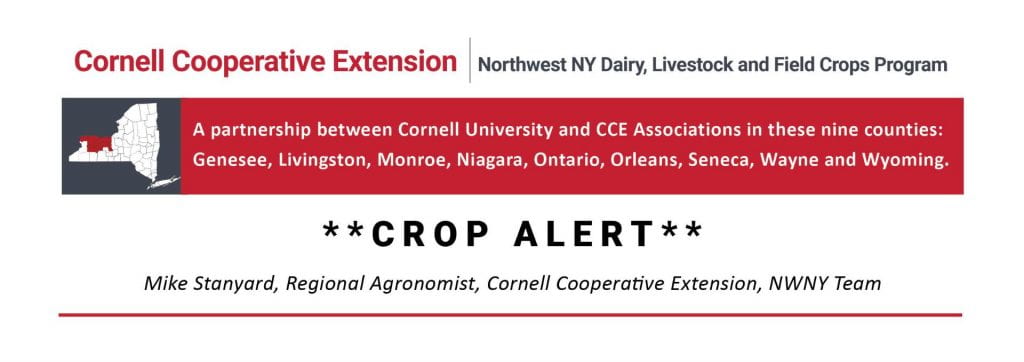Yellow Soybeans: How’s Your Nodulation?

The region has had a lot of heavy rain in the past two weeks. Many soybeans were under water and have been sitting in saturated soils with wet feet. Most of these lower spots have turned off color, yellow and even died. Are these fields going to recover? Even though fungal diseases could become an issue, I like to first look at the number of nodules on soybean roots. Saturated soils make it tough for the beneficial bacteria to find an appropriate site on root hairs to form nodules. Shawn Conley from University of Wisconsin does a good job summarizing nodulation questions in this article. He states that it is not about quantity of nodules but quality. Remember, when you break open a nodule, it should be pink inside if it is actively producing nitrogen. Purdue University also has a video online called “Soybean Nitrogen Stress After Wet Conditions”. They state that during the vegetative stages there should be double the number of nodules as there are trifoliates (ie. V7 should have at least 14 nodules). If nodules are absent or greatly reduced, 50 pounds of N can help the plants along until nodules can get themselves established. Hopefully, as fields dry up a bit, soybeans can get back to themselves and start growing again.
Start Scouting for Corn Leaf Diseases
With this wet and humid July, I have been anticipating corn leaf diseases and it looks like both are starting to be found. Northern Corn Leaf Blight (NCLB) is the most common threat in NWNY while some low pockets may also see Gray Leaf Spot (GLS) which is a bigger yield threat. It is very easy to tell these diseases apart once they get established. NCLB has the large cigar shaped lesions while GLS legions look like wooden matchsticks (see photos). Many fields have begun to tassel (VT) and silk (R1). This is a crucial time for scouting corn and determining if a fungicide application is warranted. Hopefully, you have planned ahead and planted hybrids with the highest level of resistance. Even though spores can move long distances, continuous corn fields and no-till/reduced till fields with lots of corn residue are also the most vulnerable from local spore development and dispersal. Go to Cornell’s Field Crop webpage to learn more about both of these diseases.


Dr. Paul Pierce from Ohio State University has some good points for making fungicide application decisions.
- Susceptible hybrids: If disease symptoms are present on the third leaf below the ear or higher on 50% of the plants examined, a fungicide is recommended.
- Intermediate hybrids: If disease symptoms are present on the third leaf below the ear or higher on 50% of the plants examined, AND the field is in an area with a history of foliar disease problems, the previous crop was corn, and there is 35% or more surface residue, and the weather is warm and humid through July and August, a fungicide is recommended.
- Resistant hybrids: Fungicide applications generally are not recommended.
The full article, “Foliar Diseases and Fungicide Decisions in Corn”, can be found on Ohio State University Extension’s website.
Upcoming Events
2021 New York Corn & Soybean Growers Summer Crop Tour
 August 5, 2021 – 11:00am to 7:00pm
August 5, 2021 – 11:00am to 7:00pm
Catalpa Farms
1921 County Rd 8, Canandaigua, NY 14424
Register Online by August 4th.
Agenda
11:00 am Registration/Exhibits/Mini Food Truck Rodeo
1:00 pm Welcome
1:15 pm Breakout Sessions Begin
- Herbicide Resistant Soybeans: Know Your Genetics -Mike Hunter & Mike Stanyard, CCE
- Improving Pigweed Identification Skills to Increase Weed Control-Lynn Sosnoskie Cornell University
- Late Season Fungicide in Corn: Tools for a Successful Application – Chris Flansburg & Tom Sutter, LandPro Equipment
3:00 pm -Opportunities for Biofuel Feedstock Producers and Biofuel Manufacturers in Legislated Low Carbon Fuel Markets-Ron Alverson, Crop Producer, American Coalition for Ethanol BOD, Dakota Ethanol BOD
3:30 pm Biofuels and their role in Decarbonization-Tristan Brown, SUNY ESF
4:00 pm Keynote Rob Sharkey-The Shark Farmer
5:00 pm NY Craft Beverage Tasting sponsored by Howlett Farms
Cornell Hemp Research Team Field Day (Hybrid)
 August 12, 2021 – 8:00am to 12:30pm
August 12, 2021 – 8:00am to 12:30pm
Cornell AgriTech McCarthy Farm
2865 County Road 6, Geneva, NY
Hybrid event – in-person and broadcast live and recorded on Zoom to provide updates on Cornell hemp research. This outdoor field event will have two farm locations with multiple presentations with the first location focusing on cannabinoid hemp research and the second on grain and fiber hemp and seedless triploid cannabinoid hemp.
Hemp growers, processors, and crop management advisors are encouraged to attend. Pre-Registration required.
Unvaccinated individuals must wear a mask outdoors when physical distancing is not possible.
Registration is free. Limited to 200 in-person attendees. It would be greatly appreciated if you register on or before August 10, 2021.
Agenda:
8:00am In-Person registration and coffee
9:00am Welcome – Larry Smart, Cornell University
9:00am NYS Ag and Markets Update/Q&A, Tim Sweeney, NYS DAM
9:15am – 10:45am ~ Cannabinoid Hemp Field Tour Presentations (rotating groups)
- Disease Management in CBD Hemp, Ali Cala, Patrick McMullen & Chris Smart, Cornell University
- Evaluation of 40 CBD and CBG Cultivars, Maylin Murdock, Cornell University
- Genetic Basis for Autoflower and Flowering Time, Jacob Toth, Cornell University
- Establishing the USDA ARS National Hemp Germplasm Repository, Zachary Stansell, USDA
10:45am Drive to Research North Farm, 1097 County Road 4
11:00am – 12:30pm ~ Grain/Fiber Hemp Field Tour Presentations (rotating groups)
- 2021 Grain/Fiber Variety Trial, Jamie Crawford, Cornell University
- Evaluation of Triploid Seedless CBD Cultivars, Larry Smart, Cornell University
- Evaluation of Fiber and Dual-Purpose Varieties in Strip Trials, Luis Monserrate, Cornell University
- Weed Management and Herbicide Compatibility with Hemp, Liz Maloney, Cornell University


